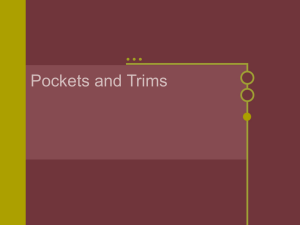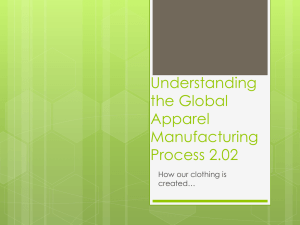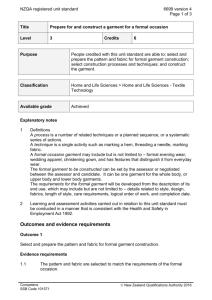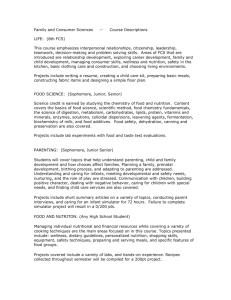TRIMS AND FINDINGS Chapter 8 Findings and Trims Findings
advertisement
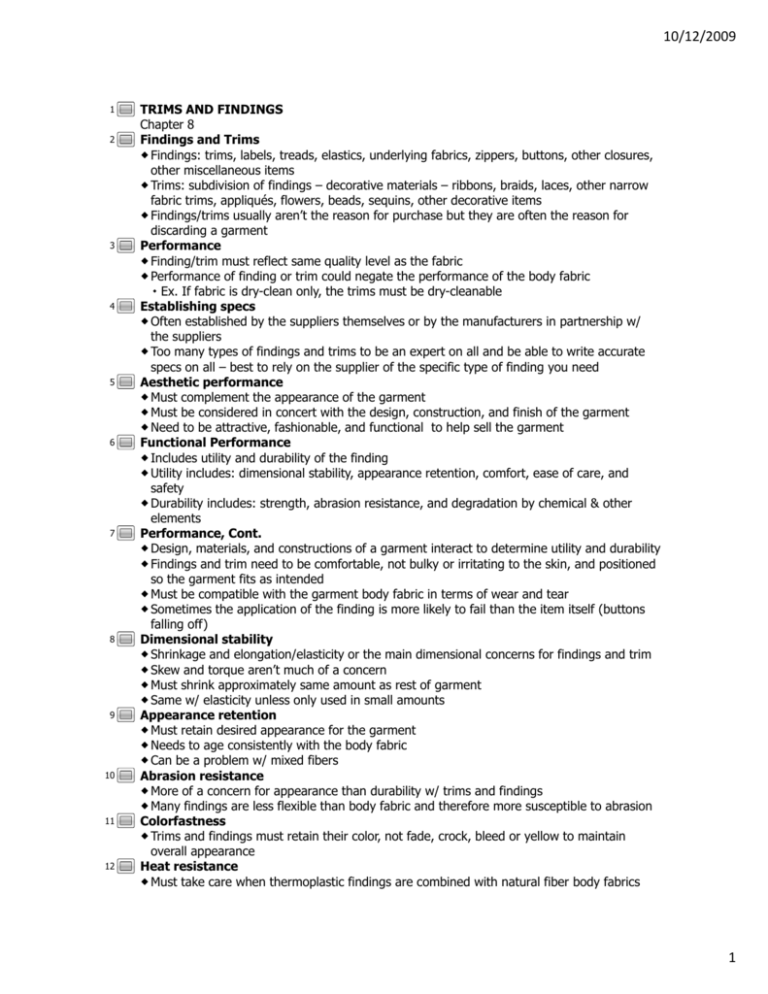
10/12/2009 1 2 3 4 5 6 7 8 9 10 11 12 TRIMS AND FINDINGS Chapter 8 Findings and Trims Findings: trims, labels, treads, elastics, underlying fabrics, zippers, buttons, other closures, other miscellaneous items Trims: subdivision of findings – decorative materials – ribbons, braids, laces, other narrow fabric trims, appliqués, flowers, beads, sequins, other decorative items Findings/trims usually aren’t the reason for purchase but they are often the reason for discarding a garment Performance Finding/trim must reflect same quality level as the fabric Performance of finding or trim could negate the performance of the body fabric Ex. If fabric is dry-clean only, the trims must be dry-cleanable Establishing specs Often established by the suppliers themselves or by the manufacturers in partnership w/ the suppliers Too many types of findings and trims to be an expert on all and be able to write accurate specs on all – best to rely on the supplier of the specific type of finding you need Aesthetic performance Must complement the appearance of the garment Must be considered in concert with the design, construction, and finish of the garment Need to be attractive, fashionable, and functional to help sell the garment Functional Performance Includes utility and durability of the finding Utility includes: dimensional stability, appearance retention, comfort, ease of care, and safety Durability includes: strength, abrasion resistance, and degradation by chemical & other elements Performance, Cont. Design, materials, and constructions of a garment interact to determine utility and durability Findings and trim need to be comfortable, not bulky or irritating to the skin, and positioned so the garment fits as intended Must be compatible with the garment body fabric in terms of wear and tear Sometimes the application of the finding is more likely to fail than the item itself (buttons falling off) Dimensional stability Shrinkage and elongation/elasticity or the main dimensional concerns for findings and trim Skew and torque aren’t much of a concern Must shrink approximately same amount as rest of garment Same w/ elasticity unless only used in small amounts Appearance retention Must retain desired appearance for the garment Needs to age consistently with the body fabric Can be a problem w/ mixed fibers Abrasion resistance More of a concern for appearance than durability w/ trims and findings Many findings are less flexible than body fabric and therefore more susceptible to abrasion Colorfastness Trims and findings must retain their color, not fade, crock, bleed or yellow to maintain overall appearance Heat resistance Must take care when thermoplastic findings are combined with natural fiber body fabrics 1 10/12/2009 13 14 15 16 17 18 19 20 21 22 Can affect overall care proceedures Comfort Hand of findings is very important As is the size and shape of findings – such as with buttons Ease of care Findings should have the same launderability or dry-clean-ability as the body fabric Safety Flame resistance Sharpness or choking hazards Ability to reflect light Strength Strength needs to be specified amount of strength proportional to the end use of the garment Resistance to Degradation Must withstand degradation from the environment Chemical resistance Launderability and dry-cleanability Light resistance Fume fading resistance Physical Features Include its base raw material Its structure How it’s dyed, printed, and/or finished Size, placement, attachment, reinforcement Cost limitations and lead times are factors in choice Cost does not directly predict the quality of a finding, but is often related Method of application must be considered Many items purchased by the gross Labels Different types: Printed: preprinted and self-printed Woven Different shapes, different materials Paper labels Attachment methods, durability of materials, and comfort are important factors Thread Used for sewing the garment as well as for decorative topstitching and for embroidery Often least costly Thread failure can cause failure of entire garment Strength, durability, appearance, and texture important Thread strength Critical to durability of stitches and seams Breakage slows down production Single end strength – strength required to break the thread Loop strength – force necessary to separate two stitches Some need to resist stretching, some need to stretch a little Some require coarse, multiple threads, some need fine threads Some need abrasion resistant threads Fiber content of thread Polyester & nylon: stronger and more resistant to wet processing chemicals Cotton: weaker & less resistant to chemicals, but excellent sewing characteristics Mercerized cotton: stronger than soft, unfinished cotton 2 10/12/2009 23 24 25 26 27 28 29 30 31 Rayon: weak, but shiny and dyes well Silk: rare, costly, but beautiful Thread types Spun vs. filament Spun: Staple fibers (natural except silk or synthetics and silk cut into staple fibers) Usually two to six single spun yarns are twisted together to make a spun thread Usually plain spun thread is not as comfortable as core-spun, but cheaper But are usually more comfortable than filament threads Corespun Subcategory of spun threads Each ply consists of a spun core of polyester or nylon wrapped with cotton or other fibers Usually requires several plies twisted together to make a thread Usually finer, stronger, softer, more elastic than plain spun More costly, so used on critical seams rather than all Filament threads Made of filament fibers: silk or synthetics Multifilament vs. monofilament threads Monofilaments Most common filament thread Made of a SINGLE filament – like a fishing line Often clear Used to avoid multiple color changes Very strong, can be too strong Can irritate the wearer’s skin Often only used in lower end garments and/or hems Multifilament threads Consists of several filaments twisted together Makes a very strong thread High luster, low coverage, slick May be texturized (reduces luster, increases coverage and comfort) Thread color Well-coordinated thread color is a mark of quality Hue, shade, luster should match or coordinate A shade darker is best Basic colors can be used in places that don’t show to save costs Should be colorfast Thread size Uses the Tex system Higher numbers are heavier and lower numbers are lighter See appendix C in text Trim Type and amount is often influenced by fashion trends Shouldn’t ravel, fall off, shrink, fade, bleed, or discolor Should be compatible with the wear and care requirements of the rest of the garment Complex trims generally cost more than simple ones and wide more than narrow Ribbon Narrow, woven fabric used as a trim and to make ties and bows Includes: Grosgrain ribbon Satin ribbon 3 10/12/2009 32 33 34 35 36 37 38 39 Velvet ribbon Novelty ribbon Picot-edge ribbons or feather edge ribbons Ruching Braid Formed by the intertwining of a set of yarns according to a definite pattern to form a narrow fabric Includes: Soutache Middy braid Loop braid Scrolling Gimp Rick-rack Foldover braid Lace Trim Narrow lace fabric (as opposed to allover lace) Includes: Insertion: flat, 2 straight edges Galloon: flat, 2 scalloped edges Edging: flat OR gathered, one straight edge, one scalloped Beading lace: has holes to run ribbon through Medallion: individual lace motif (ex. Appliqué) Other Narrow Fabric Trims Many have no name other than trim Some that do include: Piping Corded piping Bias tape Seam or hem tape Twill tape Fringe Appliqués Decorative fabric patches applied to the garment Often die cut from fusible-back fabric Then ironed on and stitched Nonfabric trims Include beads (seed, bugle, pearls), sequins (paillettes, spangles),, nailheads (flat), studs (raised), rivets, burrs, plastic & silk flowers, feathers, jewels Trim and application must match garment’s care methods Closures The fasteners that secure garment openings Influenced by fashion Must take into account care methods , design and production needs Buttons Often decorative as well as functional But can be hidden – strictly functional Or decorative – without function Composition of buttons Least costly are molded plastic or stamped from sheet plastic (polyester or nylon) Natural materials (mother-of-pearl, shell, wood, metal, horn) typically cost more Self-covered buttons can be used to blend w/ garments 4 10/12/2009 40 41 42 43 44 45 46 47 48 49 Leather, wood, rhinestones can be damaged by certain cleaning proceedures Button size Sized in lignes (lines) 40 lignes = 1 inch diameter, 30 ligne = ¾” Usually size chosen in proportion to the size of the garment Consider placement and customer when choosing size (kid’s buttons, buttons down center back…) Number of buttons depends on button size. Larger buttons are farther apart, smaller buttons, closer. Button types Eyed or shanked Eyed: generally more casual, creates less lump Shanked: can be dressier, bulkier, cost more Button loops Used sometimes in place of buttonholes Made of narrow tubes of bias fabric, cord, thread chains, or elastic Must have adequate size and elasticity to slip over button Frogs – highly decorative button & loop closure Toggle – decorative button & loop closure used on heavy fabrics Zippers Fast & easy means of getting and out of garments More appropriate than buttons for FLAT areas within garments NOT suited for bloused areas due to stiffnes Usually preferred over buttons for fitted garments to prevent gapping More comfortable to lean against, great for BACK closures Buttons are more decorative and preferred for FRONT closures Zippers usually less costly Zipper Parts Tape, chain, slider, pull, top and bottom stops Zipper tape Can be woven or knit Woven usually stronger Knit usually more flexible – usually not used for metal zips Zipper chain The part of the zipper that interlocks when the zipper is closed The part that is most likely to fail Can be plastic or metal Plastic – more flexible Metal – stronger Can be separate elements (teeth) or continuous elements (coil zippers) – metal can only be separate Zipper slider The part that glides up and down to open and close the zip Has a pull or tab for grasping – sometimes decorative Many have some sort of locking mechanism to prevent the zipper from coming open Top and bottom stops Prevent the slider from coming off either end Better when placed on top of the chain than below If no stop is present, then the chain must be caught in the seam or stitching at top and bottom Zipper size By width of chain in millimeters from 1 to 9 5 10/12/2009 50 51 52 53 54 55 56 Larger ones cost more but are stronger Must balance size with aesthetics and performance needs Zipper length Having a zipper in a seam is more expensive than having a plain seam. Zips are priced by length. Therefore, the shortest possible zipper is usually used. Must be long enough so that the opening created by the zip is large enough for dressing and undressing with ease and no stress or strain on the garment Zipper chain composition Metal: Brass Nickel Zinc Aluminum Alloys Plastic nylon Zipper Types Conventional Separating Invisible Miscellaneous Novelty Trouser zips Dress zips Reversible zips Two-way Snap fasteners Two types: sew on & mechanically attached In general, can’t stand as much stress as buttons, zippers, or hooks & eyes Sewn-on: usually light to medium weight Hand or machine attached Have 2 parts Can be covered Mechanically-attached: usually medium to heavy weight Attached by machines or presses Has 4 parts Strongest and most durable type Snap Size Small – less gripping power, less bulk Large – more gripping power, more bulk Chose according to weight of fabric, location & job of snap Sized 12 ligne to 30 ligne usually Snap composition Can be make of steel, brass, nickel, coated w/ nickel, zinc, or enamel paint Steel is strongest but rusts Clear plastic Mechanically attached snaps can by capped w/ plastic, glass, metal, mother-of-pearl, Snap tape Strip of fabric (twill tape), onto which the snaps are mechanically attached by the supplier Used to apply a series of snaps Snaps are evenly spaced and secure Easier to apply, but spacing is fixed 6 10/12/2009 57 58 59 60 61 62 63 64 65 Hooks and eyes Small and easy to conceal but can carry a heavy stress load – heavier than a snap of similar size Use instead of snap where there is heavy strain Usually a concealed closure Size Small – less strong, large – quite strong Numbered sized 0-3 Special large, flat plates for pants waistbands Composition Usually metal – same as snaps Some special ones such as: Bra hooks Gimp or thread covered hooks and eyes Eye types Round (curved Straight (bar) Adjustable Fabric loop Thread loop or chain Usually applied at stress point Can have hook and eye tape Hook and Loop Tape Velcro Usually place hook side up and loop side down Can be very stiff Easier to manage than other closures for certain groups of people Typically a concealed closure Miscellaneous closures D-rings Buckles Eyelets & grommets Cords or ties Underlying Fabrics Interfacings, linings, underlinings, interlinings Lend shape and support to garments Narrow (less than 12” wide) underlying fabrics count as findings. The rest are considered fabrics Interfacing Range from extremely lightweight (about .4 oz/yd2) Lend soft or light support To very heavy fabric (about 4 oz/yd2) Crisp or heavy support Too heavy or too stiff interfacing overpowers the fashion fabric Must withstand same wear & care as the garment Self-fabric interfacings usually cost more Structure of Interfacings Woven: Strong Adds shape w/o looking boardy – if correct weight Does not stretch, adds stability Must be cut on grain for stability or bias for rolls 7 10/12/2009 66 67 68 69 70 71 Tends to ravel More costly that other types Structure of Interfacings Knit: Stretch – well suited for knit garments Adds softer shape and drape Does not ravel, but may curl Must be cut “on-grain” Costs less than woven Weft-insertion knits feature an extra filling yarn that provides stability w/o sacrificing drape & flexibility Structure of Interfacings Fiberweb (nonwoven): Generally lend good stability Not very drapable Have no grain – allows for tighter marker Does not ravel, some may curl Often less durable Propensity to pill Usually least costly Fusible vs. sew-in Fusible: most common Slightly stiffer Make face fabric very stable Provide a slightly flatter shaping Bond to the fibers and prevent them from migrating to the surface, retarding pilling Do not teat or roll as easily Must be tested for ease of production and compatibility with care of body fabric Make sure there’s no strike-through Fusible vs. sew-in Sew-in: stitched into garment Provide body w/o stiffness of fusible Can hide seam allowances Can cause slight puckering if they shrink differently from the fashion fabric Often preferred in knit garments – leaves loops free rather than glued Used extensively in finely tailored and couture garments Lining Fabrics Choice depends on the fashion fabric, the end use, and price line Most are woven – more stability Satin weaves are common because they slip easily Lining Fabrics A HIGH quality lining fabric: Is smooth – to slip on/off Lightweight and non-bulky Resistant to staining Able to withstand the same wear as the garment Has same care requirements as garment Adds warmth to cool-weather garments, adds as little warmth as possible to warmweather garments Is absorbent Static-free 8 10/12/2009 72 73 74 75 76 77 78 79 80 Opaque Complementary color or pattern Underlining Fabrics Many are the same fabrics as used for linings Tend to use fabrics that lend shape more and are less concerned w/ slipperiness Interlining Fabric Lightweight and nonbulky Withstand same care as the garment Thinsulate, Thermaloft, poly fleece Down, lambswool Other shaping/supporting devices Some order in lengths, some ordered ready-made in units Need to match care needs of garment Need to be ordered early and figured into cost of garment Elastic A fabric w/ a high degree of stretch and recovery Includes: Swimwear elastic Plush-back elastic Lingerie elastic Stretch lace Pajama elastic Nonroll elastic Type must be know during patternmaking and production spec-ing Fiber content of elastic Rubber or elastic Can be synthetic rubber Each has different properties and different resistances Structure Woven, knitted, or braided Braided: excellent stretch, bulky, can’t be directly stitch to fabric Woven: heavier, more stable, firmer control, more costly, may be stitched directly to fabric Knitted: soft and lightweight, less costly, may be stitched directly to fabric Width Width should be comfortable and give the disired look Wider: more expensive Most narrow is elastic thread Elastic cording Wide elastic is less apt to dig into skin Belts Help hold the garment in position Self-belts are made of the same fabric Others can be made of other fabric, vinyl, metal, leather, or other things. Typically ordered from a supplier Usually not super high quality (those are sold separately) Often increases hanger appeal Shoulder pads Shaping device in tailored jackets and coats Also used in shirts, blouses, dresses as fashion demands Vary from ¼” to inch or more in thickness Shape also varies Can be made from foam, polyester batting, or cotton batting 9 10/12/2009 81 82 83 84 85 86 87 88 89 Must be able withstand care methods w/o balling up or disintegrating Removable ones can be a selling point Chest pieces Shaping device in tailored jackets and coats – particularly in menswear Fills out and smoothes the hollow between the shoulder and the chest near the armhole Low-priced garments may fuse it to the front panel Higher-priced garments have floating chest pieces that give a less stiff appearance Sleeve heads 2 or 3 layers of shaping fabrics sewn into the upper portion of the armhole and extending out into the sleeve Used in some tailored jackets and coats to create a soft, smooth roll in the cap of the sleeve w/o creating a hollow, ridge, or lump across the top of the sleeve Can also be used in puff sleeves to maintain the shape – made of stiffer material in that case Seam stays and bridles Bridle – a stay tape (twill tape) sewn along a roll line or seam edge to enable the line/seam to hold a better shape Collar Stays Thin plastic strips inserted in collars (NOT button-downs) that make the stay flat and not curled Can be removable, but more often sewn in Bra cups Provide support, shape and smoothness to the bustline of swimsuits, strapless gowns and other garments Often contain fiberfill or foam to enhance size and shape of bust Must be able to withstand same care method as garment Hoops and Bustles Large plastic or metal rings: hoops Used to support full skirts Can be sewn directly into dress or be in a separate petticoat A basket-like device used to expand the back of skirt: bustle Both are highly affected by the whims of fashion Currently used primarily in fashion and costume Horsehair braid Used to face and stiffen hems in wedding and formal gowns w/ full skirts A stiff narrow braid now made of sheer nylon filament Can be as wide as 4” Weights Usually only found in high quality garments Lead weights that are encased in fabric Tacked into key places to maintain proper garment drape and drag Most frequently in hems Sometimes in cowl necklines Or used to prevent lightweight skirts from blowing up Dress shields Underarm shields Usually only in high-end garments Meant to absorb perspiration and extend the life of a garment May be tacked in place for easy removal and laundering 10

